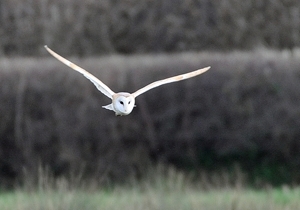Barn owl
 Barn owls have had a tough couple of years due to the inclement weather we have recently experienced – in fact 2013 was the worst breeding season for the species ever recorded. However, this year I am getting reports of large broods of owlets in nest boxes which appear to be doing well, supported by high numbers of short-tailed field vole around for them to feed on.
Barn owls have had a tough couple of years due to the inclement weather we have recently experienced – in fact 2013 was the worst breeding season for the species ever recorded. However, this year I am getting reports of large broods of owlets in nest boxes which appear to be doing well, supported by high numbers of short-tailed field vole around for them to feed on.
Barn owls are hugely popular amongst country folk. When you ask farmers for instance what their favourite bird is, they commonly state the same 3 birds in their reply – the grey partridge, lapwing and the barn owl.
Barn owls are widely distributed across the UK being found everywhere except on the high ground of Scotland and Northern England, but they suffered declines during the 1950s and 1960s due to the widespread use of organochlorine pesticides such as DDT. In more recent times however, despite the last couple of difficult years, barn owls have generally been doing well, with numbers on the increase since the mid 1990s.
Farmers have played an important part in helping the barn owl population to thrive once more by planting grass margins alongside arable fields and leaving field corners of tussocky grass – ideal habitat for attracting small mammals on which the owls feed. However, many good barn owl nesting sites have been lost as redundant farm buildings were converted for non-agricultural use, or completely modernised to become totally secure, with no gaps for the owls to enter any longer.
Once again farmers have helped out, as they have been busy putting up nest boxes for their owls, even allowing barn owls to occupy areas such as the fens that were previously devoid of suitable nesting sites. It is now estimated that three-quarters of British barn owls live in man-made nest boxes, so perhaps we should be changing their name to the “box owl”!
The barn owl is sometimes called the white or ghost owl because it has a white face and undercarriage. You might think that this would make it rather conspicuous when hunting its prey, but in fact this white underside works as an anti-silhouette strategy. When viewed from below most birds appear as a dark silhouette, so to counteract this, the best colour to be is actually white.
The barn owl's heart-shaped face works in a similar way to our outer ears – collecting and directing sounds toward the inner ears. The ear openings are situated inside the facial disc just behind the eyes. They are shaped differently and placed asymmetrically (one higher than the other). As a result, sounds reaching the two ears are heard very differently. By analysing these differences the owl's brain automatically calculates the exact position of the sound-source. Experiments with captive owls have confirmed that they are able to locate and capture prey in total darkness – using their hearing alone.
What is more, they need to be to be pretty good at hunting as on average a wild barn owl eats about four small mammals per night: that's 1,460 per year! The most frequently taken prey is the short-tailed field vole which usually forms between 40% and 80% of the diet, while wood mice and common shrews are also commonly taken.
A few years ago, while restoring the fireplace of an old farmhouse in Hampshire, a deposit of barn owl pellets was found in the chimney which had been sealed in 1911. This deposit effectively represented the diet of a barn owl from a century ago. This diet was remarkable in that it had a much greater variety of prey species compared with modern diets from that area. It included bats, harvest mice, moles, water voles, frogs, birds and beetles, as well as the small mammals that we find today. Even today barn owls will prey on a range of unsuspecting species – one pellet from an Essex-based owl was once found to contain a BTO ring which had been fitted to a wren in Northumberland!
Barn owls are notoriously faithful to their natal area, usually living out their lives in the county that they were raised in. This is well demonstrated by the oldest barn owl ever recorded which was ringed as a nestling in Essex in 1996 and recaptured by the same person in 2011! In its 15 years and 26 days of life it had travelled the grand distance of 4km.
Finally, I want to reassure you that the old custom of nailing an owl to a barn door to ward off evil and lightning – which persisted into the 19th century – is luckily now illegal! Another traditional English belief was that if you walked around an owl in a tree, it would turn and turn its head to watch you until it wrung its own neck. I’m not sure about that one; if you try it and it works let me know!
Peter Thompson
Advisory
Read more from Peter Thompson at the Fresh from the Field blog.

Download Peter Thompson's essential 26-page book, featuring beautiful photography and detailed profiles of Britain's wildlife
Download FREE >